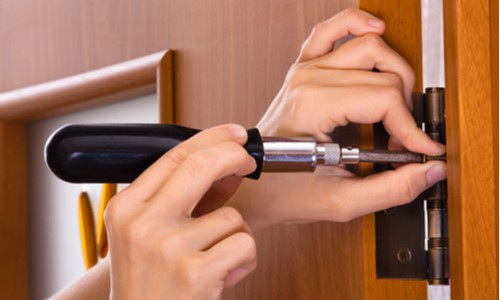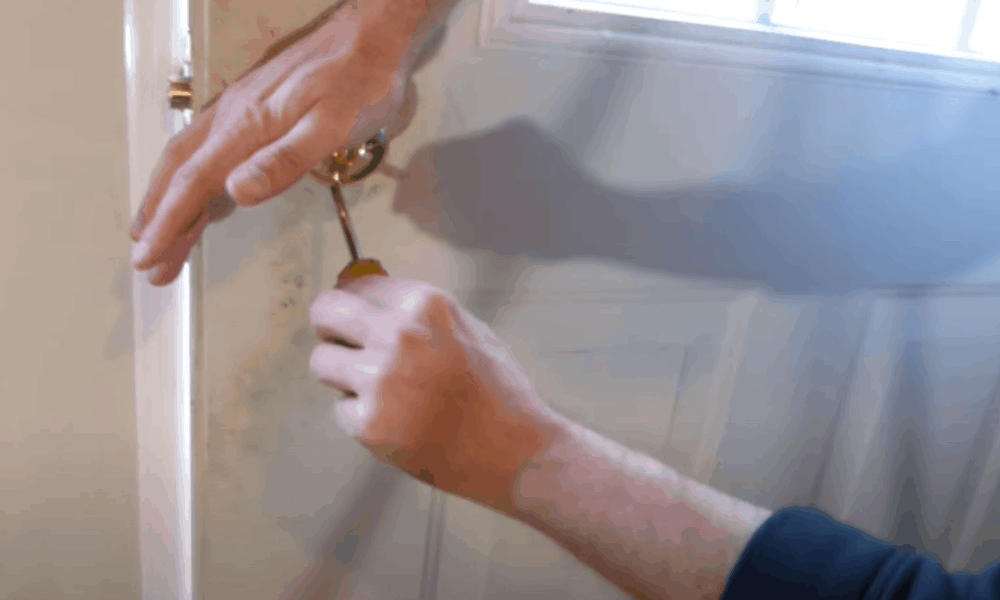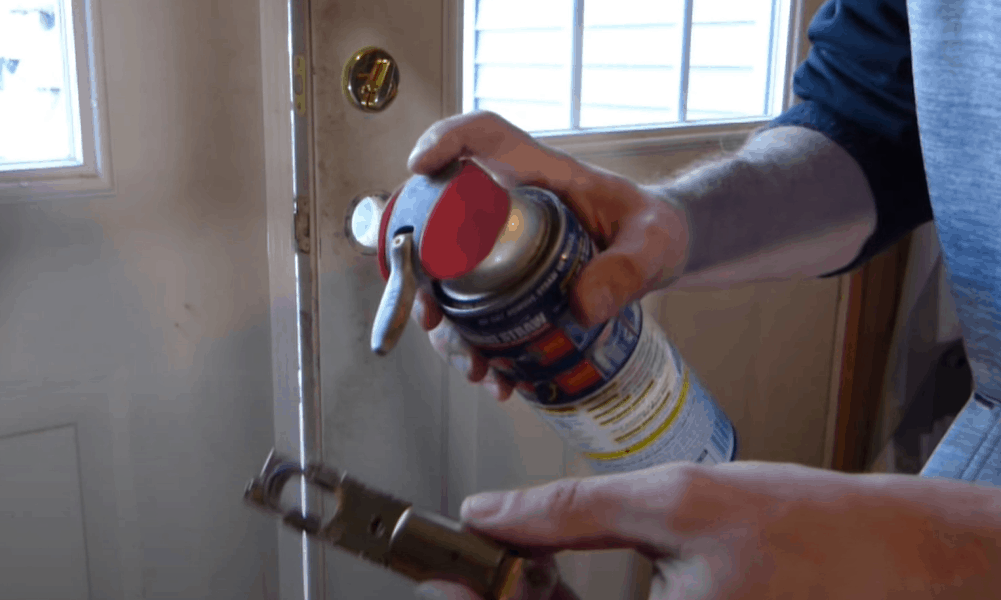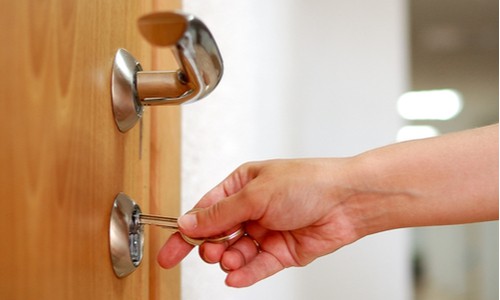Anything from a misaligned deadbolt, loose setscrews, or rust can keep your locks from working properly. There is no one way to fix a door lock that is jammed; the method you use will depend on the cause of the jam. If all this sounds complex, don’t worry; it isn’t. With just a few handy tools and basic materials, your lock will be as good as new.
Tools
Below are the tools you will need to fix a jammed door lock.
- Philips-head screwdriver or an appropriate screwdriver
- Key extractor
Materials
- Dry lubricant spray
Step-by-Step Guide on how to fix a door lock that is jammed
Follow these simple steps to solve problems associated with a bound door lock:
Step 1. Tighten the hinges

If a door is loose on its hinges, the latch might sit lower than the striker plate, making it difficult to operate the lock.
- Check for a gap between the door and the doorframe. If the door seems slanted, the hinges might be loose.
- Open the door to expose the hinges. Then, use a Philips head screwdriver to tighten any loose screws. This should lift the door enough for the deadbolt to slide into the striker plate in a locked position.
Step 2. Tighten the set screw

If your knob turns but won’t open the door, the problem could be a loose setscrew. This is the screw that holds the knob to the spindle that connects the interior and exterior knob. Follow these steps to fix a knob that spins but won’t open:
- Locate the setscrew. Some locks have visible setscrews located on the neck or underside of the knob. If you cannot locate any screws, you first have to take out the knob faceplate to access the screws underneath.
- Use the right type screwdriver to tighten loose setscrews. Try spraying lubricant to the screws to get them to turn easily.
Step 3. Lubricate the spring mechanism

If the deadbolt does not retract completely when you turn the knob, the lock’s interior spring mechanism might be faulty. The spring mechanism helps to turn the knob when opening and closing the door.
- Expose the spindle. Disassemble the knob and pull it out completely to expose the spindle, which is part of the lock’s spring mechanism.
- Spray a small amount of Teflon lubricant to the spindle and spring while turning the other knob. This should unbind the spring mechanism and the deadbolt should retract smoothly.
- Replace the knob and be sure to tighten the setscrew.
Step 4. Fix problems with the key

Possible causes of a key that won’t open or lock the door include ridges on the key, inadequate lubrication, and even cold weather.
- Check for ridges on the key that may prevent it from turning the lock. To do this, apply a small amount of granite on the key, insert and turn it in the lock, then take it out. The parts that do not have granite are rubbing against the interior locking mechanism and need to be filed down. The key should turn smoothly in the keyhole and unjam the lock.
- If the deadbolt will not turn with the door in an open position, try lubricating the key and keyhole to get rid of any rust that might be binding the lock.
Step 5. Repair a lock jammed by a broken key
You will need a special device, known as a key extractor to unjam a lock that’s bound by a broken key.
- Spray lubricant into the keyhole. Then, insert the ridged tip of the extractor into the keyhole. The ridges on the extractor should face the key ridges.
- Carefully slide the extractor in an in and out motion until it interlocks with the key inside. Then, gently pull the extractor from the keyhole to remove the key.
Step 6. Align the deadbolt with the strike plate
For some reason, the striker plate might shift slightly, preventing the deadbolt from sliding in the hole and locking the door. In this case, you will have to move, enlarge, or reposition the striker plate to the level of the deadbolt latch.
- To move it, take a chisel to the lower lip of the strike plate hole and slightly tap with a hammer. The strike plate should move about 1/8 inches down for the latch to slide in easily.
- If the lock is still jammed, try enlarging the strike plate hole. Use a screwdriver to remove the strike plate from the jamb. Then, use a metal file to file down the lower lip of the strike plate. Remove as much metal as is needed for the deadbolt latch to easily slide into the hole. Replace the strike plate.
- If moving or enlarging the strike plate does not solve the problem, try to reposition it. Remove the plate from the jamb and reposition it about 1/8 inches below the old screw hole. The plate hole should now accommodate the latch and unjam the lock.
Extended Tips on how to fix a door lock that won’t turn
Here are more tips to help you work around a jammed door lock.
Check for temperature-related issues
Odd as it might sound, cold or hot weather might affect the operations of your door locks and keys. If it is a cold day and the key will not turn, use a hairdryer to blow some heat on the key and keyhole. A little heat might be all that is needed to get the lock to work again.
Opt for a dry lubricant
Debris is a major cause of jammed locks. Keep dust and dirt away from the keyhole and entire lock mechanism by using a dry lubricant instead of an oil-based one. Teflon or graphite lubricants are great options.
Get your jammed door lock working with simple hand tools
A stuck door lock can throw you in a panic. Fortunately, the problem is usually small so you do not have to worry about replacing the entire lock system unless it is completely faulty. As you can see from our simple instructions, a little lubrication, and tightening the setscrews and hinges might be all that is needed to get your lock to work properly.
Do you have any questions or comments about a jammed door lock? Please leave them below—we’d love to hear from you!



![How to fix error 0xc000000e windows 10 2022 100 SOLVED 11 How to fix error 0xc000000e windows 10 2022: [100% SOLVED]](https://dreamcheeky.com/wp-content/uploads/2022/06/How-to-fix-error-0xc000000e-windows-10-2022-100-SOLVED.jpg)
![how to fix Error code 0xc0000001 2022 100 FIXED 12 how to fix Error code 0xc0000001 2022 :[100% FIXED]](https://dreamcheeky.com/wp-content/uploads/2022/06/how-to-fix-Error-code-0xc0000001-2022-100-FIXED.jpg)